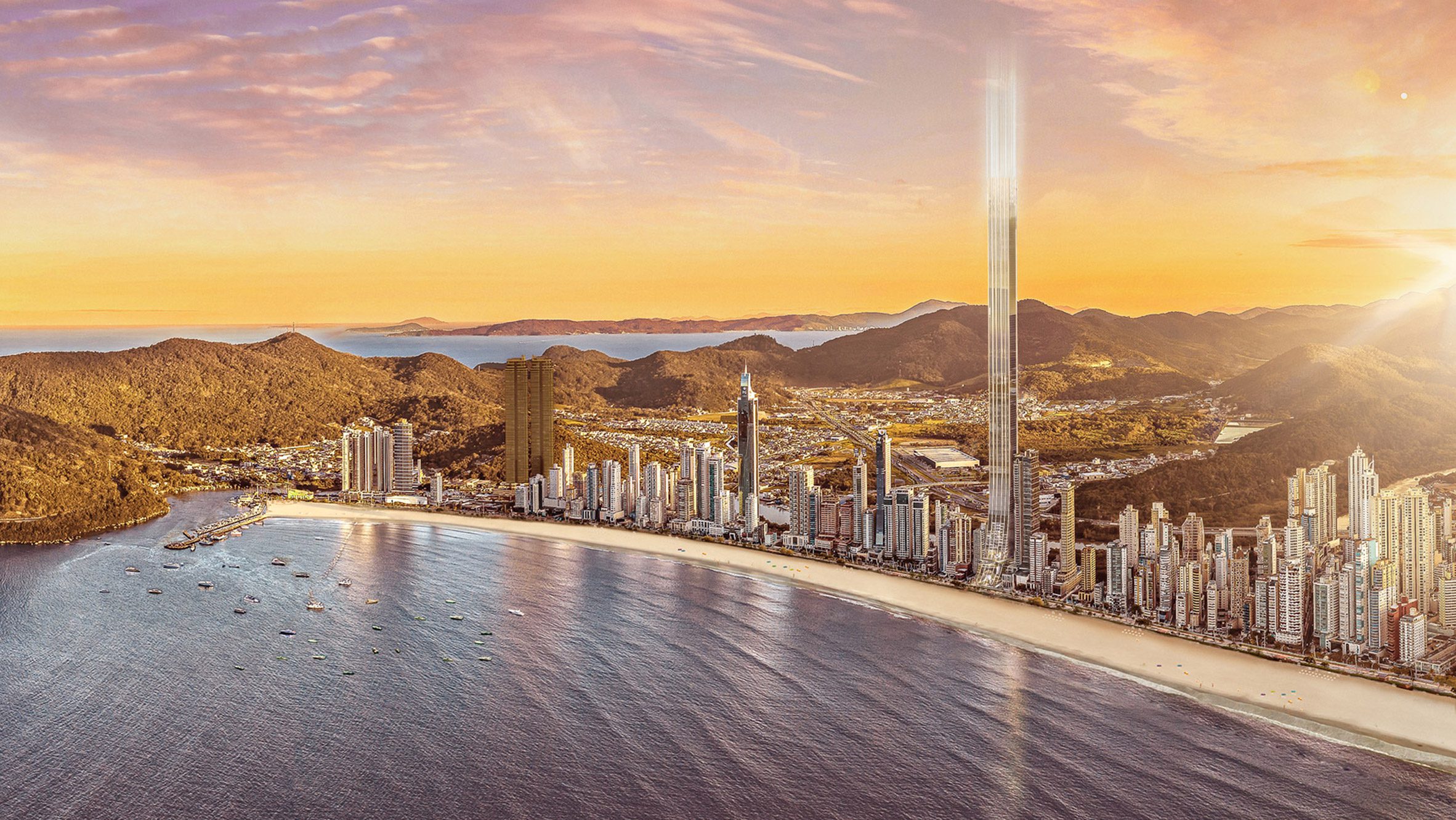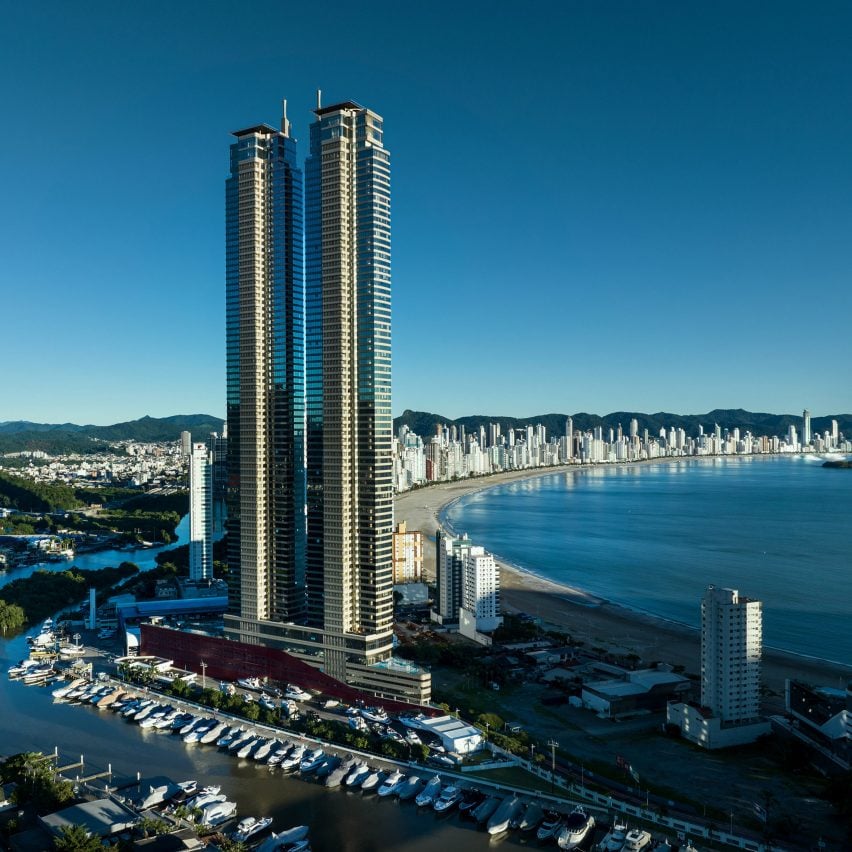Balneário Camboriú is home to three out of five of South America’s tallest buildings, set to be joined by the world’s highest residential skyscraper. Ellen Eberhardt explores how it became a developers’ high-rise playground.
Located on Brazil’s southern coast in the state of Santa Catarina, the relatively small Brazilian tourist city has become a hotbed of construction in the last few years, with skyscrapers rising to meet Brazil’s growing desire for vertical living.
It contains many of South America’s tallest buildings, as well as the most expensive plots of land in Brazil, with a permanent population roughly equal to that of Kansas City – around 150,000.
According to engineer Stephane Domeneghini, the skyscrapers of Balneário Camboriú are in part the result of the ability to pay the local government for more height.

Domeneghini is the executive director of the highrise building arm of FG Empreendimentos, Talls Solutions, the group behind Senna Tower, which is vying for the title of the world’s tallest residential skyscraper if completed.
The Senna Tower is the result of a partnership between FG Empreendimentos and Senna, the lifestyle brand behind the late Brazilian race car driver Ayrton Senna, whose niece designed the tower’s “celestial” beacon as an ode to the driver’s legacy.
“A very peculiar city”
“This city was born like this through the vision of the developers,” Domeneghini told Dezeen. “It’s a very peculiar city.”
“In the city, they have the autonomy to make this kind of laws,” said Domeneghini. “They can change the airspace for money and the city has to invest in infrastructure so [it] becomes a better environment.”

Founded by local businessman Francisco Graciola and his son Jean Graciola, FG Empreendimentos was established in 2001 following the opportunity to invest in land in Balneário Camboriú in the 1980s, according to the developer.
The duo concentrated their development efforts “with the aim of overcoming limits” in the city and, according to the firm’s website, currently oversee more than 60 companies in the construction, development, hotel, architecture, communication, services and entertainment sectors – employing more than seven thousand people.
The developer is a large part of the city’s skyline, driving the creation of eight of ten of the city’s tallest towers, two of which are the second and third tallest in the country, and owning as much as 80 per cent of the city’s beachfront properties.
As of late 2024, the company claims the largest landbank in the region with “more than three million and five hundred thousand square meters of future projects” in the works.

Projects in Balneário Camboriú include skyscrapers such as the One Tower, Infinity Coast, and the Epic Tower, all of which are listed in the top five tallest buildings in Brazil.
Italian design outfit Pininfarina recently topped out the tallest tower in the city – and country – the Yachthouse Residence Club (281 metres tall) which edged out FG Empreendimentos’s One Tower.
Embracing “iconic” heights
The Italian design company says it didn’t set out to build the city’s current tallest tower, but like FG Empreendimentos, was driven to build in Balneário Camboriú to “push boundaries”.
“Unlike many cities where zoning restrictions limit height, Balneário Camboriú embraces iconic high-rises, shaping a skyline that defines its identity,” Pininfarina of America chief architect officer Samuele Sordi told Dezeen.

“Over the years, it has undergone a remarkable transformation, with developers continuously pushing the boundaries of vertical living, resulting in taller, more exclusive residential towers,” said Sordi. “We see these conditions as an opportunity to push the boundaries of vertical architecture, crafting not just tall buildings but sculptural landmarks that contribute to the city’s evolving urban fabric.”
The city started transforming “more or less 20 years ago” according to Domeneghini, coinciding with the actions of private developers.
In the 1980s, Brazil’s federal government began introducing laws to generate more funds for local infrastructure, enforced by an individual city’s government.
In Balneário Camboriú, these new laws gave developers the ability to buy air rights directly from the city to expand skyscrapers upwards.
Coupled with “flexible” height limits, it has resulted in the urban condition of the city today, which Domeneghini compares to a city from the video game Final Fantasy.

Domeneghini notes that after running a series of zoning calculations at the project’s start seven years ago, the Senna Tower is the tallest tower possible in the city and in Brazil, in line with the extremely flexible height limits of its metropolis.
The developers worked with world-class engineers to ensure it was physically possible, such as Burj Khalifa engineer Harry Poulos and WSP senior vice president Fatih Yalnizm who has worked on a number of supertall skyscraper projects in New York such as 111 West 57th and One World Trade Center.
Density pushing cities upwards
Although she admits the city is not typical – calling it “weird”– Domeneghini believes its development reflects a larger movement to democratize and improve the quality of life in Brazil via vertical living, despite many of the city’s towers functioning primarily as second homes and the city’s reputation of supporting opulent lifestyles.
On top of loose regulations, rapid growth and traffic congestion in the populous coastal regions of Brazil have pushed cities to build higher.
The 2022 Brazilian Census noted an increase in high-rise living with 12.5 per cent living in apartments, up from 7.6 per cent in 2000.
In some cities such as Balneário Camboriú, the push upwards is generally the result of laxer zoning laws, while in others, urban density has pushed buildings upwards.
Dutch architecture studio UNStudio recently addressed some of these issues with the EZ Parque da Cidade skyscraper project in São Paulo, two residential buildings that “redefine vertical living” by introducing greenspace lost to the city’s rapid growth.
“When we design upwards, developments like EZ Parque da Cidade can of course accommodate more residents, but they also free up more space for parks, pedestrian pathways, and other human-centric amenities,” UNStudio founder Ben van Berkel told Dezeen.

“Vertical structures can also feature solutions like green terraces, natural ventilation, and energy-efficient systems, which can address issues like air pollution, noise, and lack of green spaces.”
Brazil’s mountainous geography also contributes to urban density and traffic congestion.
Cars pass through tight roads in Rio de Janeiro, and the southern city of Santos has an “insular geography” that concentrates development on accessible flat plots of land sandwiched between the mountains and coast.
Like Santos, Balneário Camboriú’s buildings are located between the mountains and the ocean. Its pristine and protected geography contributes to the city’s development as a tourist town, where the population size swells from around 150,000 to 1 million in the summer.
Domeneghini sees Balneário Camboriú as an example of the spoils of urban life and an example of where urban development in Brazil could be headed, similar to Sordi and van Berkel – cities with less traffic, where amenities, entertainment, healthcare and nature are all within walking distance, and where buying an apartment might be a more accessible option for those looking to own real estate.
“Here it is a bit more democratic, because you have these buildings, and you can have more people enjoying a good life,” said Domeneghini. “If you don’t have a house, if you don’t have food, if you don’t have water supply, you cannot think about education, about culture. You cannot transform a country if you don’t have the basics.”
“So I’m very happy that this is happening in Brazil, because I see a future [where we] can provide for more people and we can become a better country.”
The Senna Tower is set to begin construction in 2025. It is set to be over 500 metres tall, with its final height to be announced in the first quarter of 2025.
The post How a coastal city in Brazil became South America's skyscraper capital appeared first on Dezeen.

